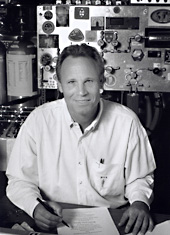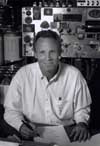Donald R. Blake,
Professor of Chemistry
[cv.pdf] [publications.pdf]
EDUCATION
- BS, Chemistry, UCLA, 1978
- MS, Chemistry, UCI, 1980
- Ph.D., Chemistry, UCI, 1984
Top
APPOINTMENTS
- Professor of Chemistry, UCI, 1998-Present
- Research Chemist, UCI, 1994-1998
- Associate Research Chemist, UCI, 1991-1994
- Research Specialist, UCI, 1985-1991
- Postdoctoral Reseach Associate, UCI, 1984-1985
AWARDS
- NASA Group Achievement Award, 1993, 1998, 2000, 2006
- Outstanding Professor Alpha Phi Society, 2000, 2002, 2005
- ACS Chuck Bennett Service through Chemistry, 2004
- Excellence in Undergraduate Research, 2001
- UCI Chemistry Department Outstanding Teaching Award, 1979
- Bank of America Chemistry Award, 1975
RESEARCH INTERESTS
Our research group is currently studying the composition of the earth's atmosphere in (a) remote locations throughout the Pacific region from Alaska to New Zealand; (b) highly polluted cities throughout the world; and (c) areas with special conditions, such as burning forests and/or agricultural wastes, or the marine boundary layer in oceanic locations with high biological emissions. Whole air samples are collected on land, ships, and aircraft and are returned to our laboratory for analysis.
Gas chromatography utilizing flame ionization detection, electron capture detection, and mass spectrometry is our main analytical tool. A three gas chromatograph analytical system is used to quantify about 150 halocarbons, nonmethane hydrocarbons, and alkyl nitrates ranging in mole fraction from about 2 parts per billion to 20 parts per quadrillion.
In an attempt to determine "background" concentrations of selected trace gases, since 1978 we have been collecting air samples at surface locatins every three months in Pacific regions from northern Alaska to southern New Zealand. Results from this "background" study recently led to our discovery that methyl bromide, a gas that significantly affects stratospheric ozone concentrations, has a tropospheric seasonal cycle. This finding provides an important constraint on hemispheric and seasonal methyl bromide sources and removal processes.
Research group members collected samples in more 25 different large cities throughout the world in an attempt to identify sources of urban pollution. Our work in Mexico City and Santiago, Chile identified leakage of liquefied petroleum gas as a major smog precursor comparable to automobiles and industrial sources. We anticipate our European and Asian urban sampling to continue into the new millennium, with projects in France, Hong Kong, and Pakistan beginning in late 1998.
Since 1988 our research group has been involved in NASA and NSF sponsored airborne projects. The general motivation for these experiments is regional or global change. For example, the 1991 and 1994 NASA Pacific Exploratory Missions were designed in part to determine baseline concentrations of trance gases and aerosols in air advected from the Asian continent. Data obtained during the 1992 NASA Transport and Atmospheric Chemistry near the Equator-Atlantic project confirmed that biomass burning emissions from Africa and South America were the cause of enhanced tropospheric ozone observed by satelite. Results from the 1992 biomass burning study were useful for understanding enhanced concentrations of biomass burning tracers observed in the mid-troposphere of the South Central Pacific during NASA's Pacific Exploratory Mission-Tropics A, a two aircraft mission flown during August-October, 1996.
Graduate students are involved in building equipment, integrating equipment onto aircraft, collecting samples during flights, analyzing the samples at our home laboratory, interpreting data, and preparing manuscripts for publication.
Top
REPRESENTATIVE PUBLICATIONS
- T.-Y. Chen, D. R. Blake, J. P. Lopez and F. S. Rowland
"Estimation of Global Vehicular Methyl Bromide Emissions: Extrapolation from a Case Study in Santiago, Chile",
Geophysical Research Letters, 1999, 26 , 283-286 - M. L. Gupta, R. J. Cicerone, D. R. Blake, F. S. Rowland and I. S. A. Isaksen.
"Global Atmospheric Distributions and Source Strengths of Light Hydrocarbons and Tetrachloroethylene",
J. Geophysical Research, 1998, 103, 28,219-28,235 - J. J. Colman, D. R. Blake and F. S. Rowland
"The Atmospheric Residence Time of Methyl Bromide Estimated from the Junge Spatial Variability Relationship",
Science, 1998, 281, 392-396 - N. J. Blake, D. R. Blake, B. C. Sive, T.-Y. Chen, F. S. Rowland, J. E. Collins, G. W. Sachse and B. E. Anderson
"Biomass Burning Emissions and Vertical Distribution of Atmospheric Methyl Halides and other Reduced Carbon Gases in the South Atlantic Region",
J. Geophys. Res. 1996, 101, 24,151-24,164 - D. R. Blake, F.S. Rowland, et al.
"Three-Dimensional Distribution of Nonmethane Hydrocarbons and Halocarbons over the Northwestern Pacific During the 1991 Pacific Exploratory Mission (PEM-West A)",
J. Geophys. Res. 1996, 101, 1763-1778, - D.R. Blake and F.S. Rowland
"Urban Leakage of Liquefied Petroleum Gas and Its Impact on Mexico City Air Quality",
Science 1995, 269, 953-956, - D.R. Blake and F.S. Rowland
"Continuing Worldwide Increase in Tropospheric Methane, 1978 to 1987",
Science 1988, 239, 1129-1131, - D.R. Blake and F.S. Rowland
"Global Atmopsheric Concentrations and Source Strength of Ethane",
Nature 1986, 321, 231-233,
ARTICLES FROM NEWSPAPERS ETC.
Recent articles are located in [News & Media]
Selected older articles are listed here:
"Samples of sky clues in puzzle", OC Register
"Half UCI chemist team famous, the other isn't", OC Register, August 18. 1995.
"Gasco se preocupa de la preservation del medio ambiente"
"Global gas hunt", OC Register, Sept 24., 1996.
"Mexicanos respiran gas propano"
PHOTOGRAPHS
| Portrait |

